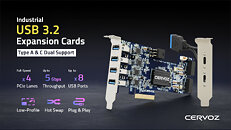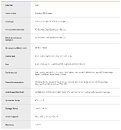TheLostSwede
News Editor
- Joined
- Nov 11, 2004
- Messages
- 18,484 (2.47/day)
- Location
- Sweden
| System Name | Overlord Mk MLI |
|---|---|
| Processor | AMD Ryzen 7 7800X3D |
| Motherboard | Gigabyte X670E Aorus Master |
| Cooling | Noctua NH-D15 SE with offsets |
| Memory | 32GB Team T-Create Expert DDR5 6000 MHz @ CL30-34-34-68 |
| Video Card(s) | Gainward GeForce RTX 4080 Phantom GS |
| Storage | 1TB Solidigm P44 Pro, 2 TB Corsair MP600 Pro, 2TB Kingston KC3000 |
| Display(s) | Acer XV272K LVbmiipruzx 4K@160Hz |
| Case | Fractal Design Torrent Compact |
| Audio Device(s) | Corsair Virtuoso SE |
| Power Supply | be quiet! Pure Power 12 M 850 W |
| Mouse | Logitech G502 Lightspeed |
| Keyboard | Corsair K70 Max |
| Software | Windows 10 Pro |
| Benchmark Scores | https://valid.x86.fr/yfsd9w |
Cervoz, a global leader in industrial-grade modules, proudly introduces its latest PCIe low-profile USB 3.2 expansion series—the MEC-USB-PL. Purpose-built to meet the rapidly growing demands for industrial connectivity, the MEC-USB-PL series is designed to offer unmatched flexibility and scalability, supporting up to 8 ports per card with both USB Type-A and Type-C connectors. The series delivers a robust and future-proof solution for a wide range of industrial applications, enabling seamless integration into modern, data-intensive operations.
Engineered for Industrial Performance and Reliability
The MEC-USB-PL series combines high port density with versatile configurations. Available in both 4-port and 8-port configurations, it allows industrial users to optimize connectivity setups based on specific needs. The 4-port model (MEC-USB-PL004) is ideal for applications needing focused, high-speed data transfer across devices, while the 8-port models (MEC-USB-PL008 and MEC-USB-PL008C) offer extensive connectivity. The MEC-USB-PL008C's mixed supporting of USB Type-A and Type-C enables compatibility across both legacy and modern devices.

High-Speed and Robust Data Transmission
With USB 3.2 standard, the MEC-USB-PL series enable data transfer speeds up to 5 Gbps per port, ensuring rapid and reliable data flow across connected devices. The performance is essential for applications requiring uninterrupted data transfer, such as automation, inspection systems, and real-time monitoring. The quad-lane PCI-Express interface further enhances data throughput, ensuring robust and consistent performance under heavy workloads.
Compact and Adaptable Form Factor
Designed for space-constrained environments, the series features a compact, low-profile design (68.90 x 158.00 mm) fitting easily into embedded and tight industrial setups, allowing users to incorporate high-density connectivity into compact systems without sacrificing valuable space. The series offers both standard and low-profile bracket options, ensuring seamless integration into various system configurations.
Advanced Power Managemen
One of the standout features of the MEC-USB-PL series is its advanced power management capabilities. The series offer adjustable power output (between 900mA and 1500mA), allowing users to tailor power delivery to match the needs of their connected peripherals. Additionally, the multiple power input configurations ensure stable operation during power instability and fluctuation. The adaptability is critical in industrial contexts where peripherals vary in demand of power level.
A Comprehensive Connectivity Solution for the Future
The MEC-USB-PL series is engineered to bridge current and future connectivity needs. Supporting both USB Type-A and Type-C connectors, this series allows industrial users to future-proof their setups, adapting easily to evolving industrial settings without major overhauls. The forward-looking solutions support industries in maintaining adaptable, high-performance connectivity infrastructures.

View at TechPowerUp Main Site | Source
Engineered for Industrial Performance and Reliability
The MEC-USB-PL series combines high port density with versatile configurations. Available in both 4-port and 8-port configurations, it allows industrial users to optimize connectivity setups based on specific needs. The 4-port model (MEC-USB-PL004) is ideal for applications needing focused, high-speed data transfer across devices, while the 8-port models (MEC-USB-PL008 and MEC-USB-PL008C) offer extensive connectivity. The MEC-USB-PL008C's mixed supporting of USB Type-A and Type-C enables compatibility across both legacy and modern devices.

High-Speed and Robust Data Transmission
With USB 3.2 standard, the MEC-USB-PL series enable data transfer speeds up to 5 Gbps per port, ensuring rapid and reliable data flow across connected devices. The performance is essential for applications requiring uninterrupted data transfer, such as automation, inspection systems, and real-time monitoring. The quad-lane PCI-Express interface further enhances data throughput, ensuring robust and consistent performance under heavy workloads.
Compact and Adaptable Form Factor
Designed for space-constrained environments, the series features a compact, low-profile design (68.90 x 158.00 mm) fitting easily into embedded and tight industrial setups, allowing users to incorporate high-density connectivity into compact systems without sacrificing valuable space. The series offers both standard and low-profile bracket options, ensuring seamless integration into various system configurations.
Advanced Power Managemen
One of the standout features of the MEC-USB-PL series is its advanced power management capabilities. The series offer adjustable power output (between 900mA and 1500mA), allowing users to tailor power delivery to match the needs of their connected peripherals. Additionally, the multiple power input configurations ensure stable operation during power instability and fluctuation. The adaptability is critical in industrial contexts where peripherals vary in demand of power level.
A Comprehensive Connectivity Solution for the Future
The MEC-USB-PL series is engineered to bridge current and future connectivity needs. Supporting both USB Type-A and Type-C connectors, this series allows industrial users to future-proof their setups, adapting easily to evolving industrial settings without major overhauls. The forward-looking solutions support industries in maintaining adaptable, high-performance connectivity infrastructures.

View at TechPowerUp Main Site | Source






